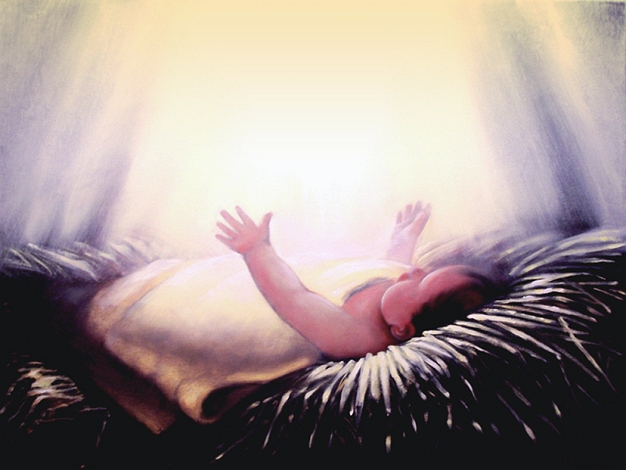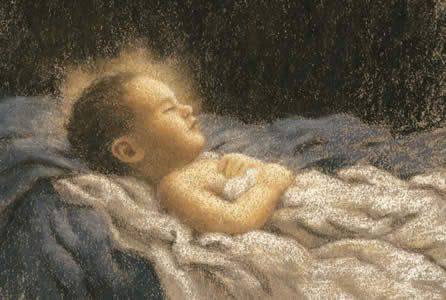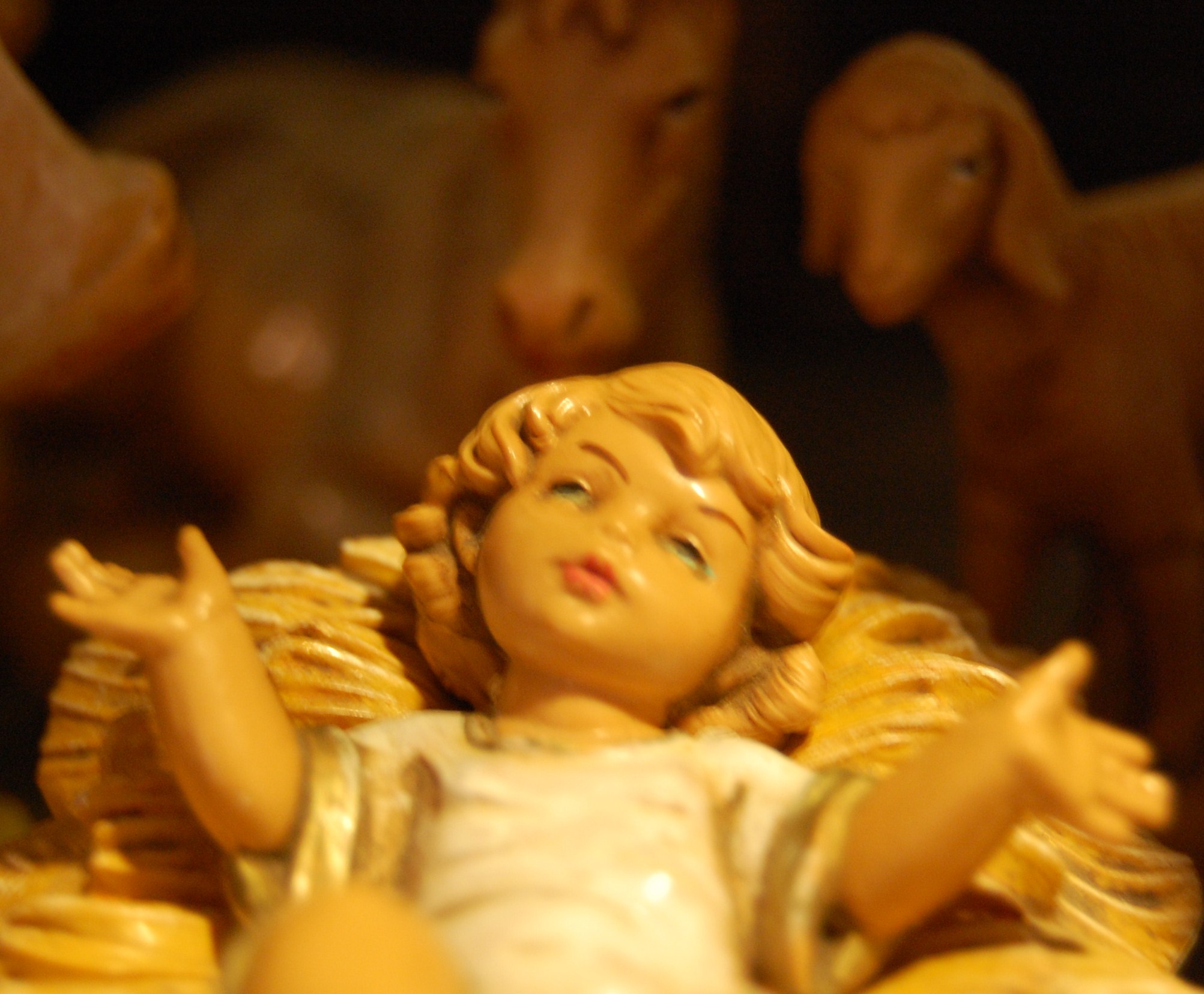Source(Google.com.pk)
Baby Jesus Biography
Jesus Christ was born in 2-6 BCE in Bethlehem, Judea. Little is known about his early life, but as a young man, he founded Christianity, one of the world’s most influential religions. His life is recorded in the New Testament, more a theological document than a biography. According to Christians, Jesus is considered the incarnation of God and his teachings an example for living a more spiritual life. Christians believe he died for the sins of all people and rose from the dead.Most of Jesus’ life is told through the four Gospels of the New Testament Bible, known as the Canonical gospels, written by Matthew, Mark, Luke and John. These are not biographies in the modern sense but accounts with allegorical intent. They are written to engender faith in Jesus as the Messiah and the incarnation of God, who came to teach, suffer and die for people’s sins.
Jesus was born between 2 and 6 BCE, in Bethlehem, Judea. His mother, Mary, was a virgin who was betrothed to Joseph, a carpenter. Christians believe Jesus was born through Immaculate Conception. His lineage can be traced back to the house of David. According to the Gospel of Matthew (2:1), Jesus was born during the reign of Herod the Great, who upon hearing of his birth felt threatened and tried to kill Jesus by ordering all of Bethlehem’s male children under age two to be killed. But Joseph was warned by an angel and took Mary and the child to Egypt until Herod’s death, where upon he brought the family back and settled in the town of Nazareth, in Galilee.
There is very little written about Jesus’ early life. The Gospel of Luke (2:41-52) recounts that a 12-year-old Jesus had accompanied his parents on a pilgrimage to Jerusalem and became separated. He was found several days later in a temple, discussing affairs with some of Jerusalem’s elders. Throughout the New Testament, there are trace references of Jesus working as a carpenter while a young adult. It is believed that he began his ministry at age 30 when he was baptized by John the Baptist, who upon seeing Jesus, declared him the Son of God.
After baptism, Jesus went into the Judean desert to fast and meditate for 40 days and nights. The Temptation of Christ is chronicled in the Gospels of Matthew, Mark and Luke (known as the Synoptic Gospels). The Devil appeared and tempted Jesus three times, once to turn stone to bread, once to cast himself off a mountain where angels would save him, and once to offer him all the kingdoms of the world. All three times, Jesus rejected the Devil’s temptation and sent him off.
Jesus returned to Galilee and made trips to neighboring villages. During this time several people became his disciples. One of these was Mary Magdalene, who is first mentioned the Gospel of Luke (16:9) and later in all four gospels at the crucifixion. Though not mentioned in the context of the “12 disciples,” she is considered to have been involved in Jesus’ ministry from the beginning to his death and after. According to the gospels of Mark and John, Jesus appeared to Magdalene first after his resurrection.
esus Christ. (Iesous, the Greek form of Joshua or Jeshua, contracted from Jehoshua, meaning help of Jehovah, or saviour; Christos, anointed). The Son of God, the Saviour of men, whose birth, life, and death were predicted by prophets, and attended with miraculous manifestations of divine power. Jesus was born of the Virgin Mary, of the tribe of Judah, who was betrothed to Joseph, the descendant and heir of the house of David. Two genealogies of Joseph are given - one by Matthew, chapter one; the other by Luke, chapter three. The former is supposed to contain the list of heirs of the house of David, whether by direct or indirect descent; the other the direct ancestors of Joseph. It was foretold that Christ should be of the seed of Abraham and the son of David. The place of Jesus' birth was Bethlehem; the time, according to the received chronology, was in the year of Rome 754. Scholars are now almost unanimously agreed that this date is too late, and it is generally placed about four years earlier.
The coming of a forerunner to the Saviour, John the Baptist, in the spirit and power of Elias, was foretold by an angel (Luke 1:17). The angel Gabriel announced to Mary that the power of the Highest should overshadow her, and that she should bear a son who should rule over the house of Jacob forever. On the night of Jesus birth, an angel appeared to some shepherds, and announced the coming of a Saviour. On the eighth day He was circumcised according to the law of Moses, and on the 40th day, was presented in the temple, where the aged Simeon pronounced Him to be the light of nations and the glory of Israel.
Herod ordered the extirpation of all children of Bethlehem and its vicinity of the age of less than two years, for the purpose of effecting the death of Jesus. But Joseph, being miraculously warned of the danger, fled to Egypt with Mary and her child, and on his return, after the death of Herod, went to reside at Nazareth in Galilee, whence Jesus is called a Nazarene. We have no further accounts of the earlier years of Jesus, except the remarkable scene in the temple when He was 12 years old, and the general observation of Luke, that He remained in Nazareth with His parents and served them.
At the age of about 30 (Luke 3:23), Jesus was baptized by John in the River Jordan, the Spirit of God descending upon Him like a dove, and a voice from heaven proclaiming, "Thou art my beloved Son; in thee I am well pleased." Previously, however, to entering on His office of divine teacher, Jesus retired to a solitary place, where He passed forty days in fasting, meditation, and prayer, previous to the remarkable scene of the temptation described by the evangelists - Matthew 4, Mark 1:12-13, Luke 4. He was afterward transfigured in the presence of three of His disciples, when Moses and Elias appeared to Him from heaven, and His raiment became white and shining, and His face shone as the sun. On this occasion again, a voice came from heaven saying, "This is my beloved Son; hear ye him" (Matthew 4, Mark 4, Luke 4:28-36).
Jesus' mission is generally considered to have occupied three years, spent in acts of mercy (chiefly miraculous), in inculcating a purer system of morals, more exalted notions of God, and more elevating views of man and his destiny than had yet been presented to the world. His doctrine is embodied chiefly in the Sermon on the Mount (Matthew 5-7 and Luke 6), containing the form of prayer He taught to His disciples, commonly called the Lord's Prayer; in His discourses to the Jews in John 5-8, and 10; to His disciples, chapters 14-16; and His intercessory prayer, chapter 17.
Jesus chose twelve apostles to be the companions of His ministry, the witnesses of His miracles, and the depositories of His doctrine; and He was betrayed into the power of His enemies by one of these with the mockery of a friendly salutation. Betrayed by one, denied by another, and abandoned by all, He was carried before the Jewish priests, found guilty, and by them delivered over to the Roman magistrates, who alone had the power of life and death. Condemned to death as a disturber of the public peace, He was nailed to the cross on Mount Calvary, and it was in the agonies of this bitter death that Jesus prayed for the forgiveness of His executioners, and with a touching act of filial love, commended His mother to His favorite disciple.
The evangelists relate that from the hour of noon the sun was darkened, and three hours after, Jesus, having cried out, "It is finished!" gave up the ghost. The veil of the temple, they add, was torn asunder, the earth shook, rocks were rent, and the tombs opened. The centurion who was present, directing the execution, exclaimed, "Truly this was the Son of God!" The body of Jesus was taken down by Joseph of Arimathea and placed in a tomb, about which the Jewish priests, remembering His prophecy that He should rise on the third day, set a guard, sealing up the door. Notwithstanding these precautions, Jesus' prophecy was fulfilled by His resurrection on the first day of the week (Sunday), and He appeared repeatedly to His disciples to encourage, console, and instruct them.
On the 40th day after His resurrection, while with them on the Mount of Olives, after He had given them instructions to teach and proselytize all nations, promising them the gift of the Holy Spirit, a cloud received Him out of their sight, and Jesus was taken up to heaven. While the disciples stood gazing after Him, two men in white apparel appeared to them, and predicted His coming again in like manner as they had seen Him go. See the closing chapters of the four evangelists, and Acts 1:1-14.










Baby Jesus Biography
Jesus Christ was born in 2-6 BCE in Bethlehem, Judea. Little is known about his early life, but as a young man, he founded Christianity, one of the world’s most influential religions. His life is recorded in the New Testament, more a theological document than a biography. According to Christians, Jesus is considered the incarnation of God and his teachings an example for living a more spiritual life. Christians believe he died for the sins of all people and rose from the dead.Most of Jesus’ life is told through the four Gospels of the New Testament Bible, known as the Canonical gospels, written by Matthew, Mark, Luke and John. These are not biographies in the modern sense but accounts with allegorical intent. They are written to engender faith in Jesus as the Messiah and the incarnation of God, who came to teach, suffer and die for people’s sins.
Jesus was born between 2 and 6 BCE, in Bethlehem, Judea. His mother, Mary, was a virgin who was betrothed to Joseph, a carpenter. Christians believe Jesus was born through Immaculate Conception. His lineage can be traced back to the house of David. According to the Gospel of Matthew (2:1), Jesus was born during the reign of Herod the Great, who upon hearing of his birth felt threatened and tried to kill Jesus by ordering all of Bethlehem’s male children under age two to be killed. But Joseph was warned by an angel and took Mary and the child to Egypt until Herod’s death, where upon he brought the family back and settled in the town of Nazareth, in Galilee.
There is very little written about Jesus’ early life. The Gospel of Luke (2:41-52) recounts that a 12-year-old Jesus had accompanied his parents on a pilgrimage to Jerusalem and became separated. He was found several days later in a temple, discussing affairs with some of Jerusalem’s elders. Throughout the New Testament, there are trace references of Jesus working as a carpenter while a young adult. It is believed that he began his ministry at age 30 when he was baptized by John the Baptist, who upon seeing Jesus, declared him the Son of God.
After baptism, Jesus went into the Judean desert to fast and meditate for 40 days and nights. The Temptation of Christ is chronicled in the Gospels of Matthew, Mark and Luke (known as the Synoptic Gospels). The Devil appeared and tempted Jesus three times, once to turn stone to bread, once to cast himself off a mountain where angels would save him, and once to offer him all the kingdoms of the world. All three times, Jesus rejected the Devil’s temptation and sent him off.
Jesus returned to Galilee and made trips to neighboring villages. During this time several people became his disciples. One of these was Mary Magdalene, who is first mentioned the Gospel of Luke (16:9) and later in all four gospels at the crucifixion. Though not mentioned in the context of the “12 disciples,” she is considered to have been involved in Jesus’ ministry from the beginning to his death and after. According to the gospels of Mark and John, Jesus appeared to Magdalene first after his resurrection.
esus Christ. (Iesous, the Greek form of Joshua or Jeshua, contracted from Jehoshua, meaning help of Jehovah, or saviour; Christos, anointed). The Son of God, the Saviour of men, whose birth, life, and death were predicted by prophets, and attended with miraculous manifestations of divine power. Jesus was born of the Virgin Mary, of the tribe of Judah, who was betrothed to Joseph, the descendant and heir of the house of David. Two genealogies of Joseph are given - one by Matthew, chapter one; the other by Luke, chapter three. The former is supposed to contain the list of heirs of the house of David, whether by direct or indirect descent; the other the direct ancestors of Joseph. It was foretold that Christ should be of the seed of Abraham and the son of David. The place of Jesus' birth was Bethlehem; the time, according to the received chronology, was in the year of Rome 754. Scholars are now almost unanimously agreed that this date is too late, and it is generally placed about four years earlier.
The coming of a forerunner to the Saviour, John the Baptist, in the spirit and power of Elias, was foretold by an angel (Luke 1:17). The angel Gabriel announced to Mary that the power of the Highest should overshadow her, and that she should bear a son who should rule over the house of Jacob forever. On the night of Jesus birth, an angel appeared to some shepherds, and announced the coming of a Saviour. On the eighth day He was circumcised according to the law of Moses, and on the 40th day, was presented in the temple, where the aged Simeon pronounced Him to be the light of nations and the glory of Israel.
Herod ordered the extirpation of all children of Bethlehem and its vicinity of the age of less than two years, for the purpose of effecting the death of Jesus. But Joseph, being miraculously warned of the danger, fled to Egypt with Mary and her child, and on his return, after the death of Herod, went to reside at Nazareth in Galilee, whence Jesus is called a Nazarene. We have no further accounts of the earlier years of Jesus, except the remarkable scene in the temple when He was 12 years old, and the general observation of Luke, that He remained in Nazareth with His parents and served them.
At the age of about 30 (Luke 3:23), Jesus was baptized by John in the River Jordan, the Spirit of God descending upon Him like a dove, and a voice from heaven proclaiming, "Thou art my beloved Son; in thee I am well pleased." Previously, however, to entering on His office of divine teacher, Jesus retired to a solitary place, where He passed forty days in fasting, meditation, and prayer, previous to the remarkable scene of the temptation described by the evangelists - Matthew 4, Mark 1:12-13, Luke 4. He was afterward transfigured in the presence of three of His disciples, when Moses and Elias appeared to Him from heaven, and His raiment became white and shining, and His face shone as the sun. On this occasion again, a voice came from heaven saying, "This is my beloved Son; hear ye him" (Matthew 4, Mark 4, Luke 4:28-36).
Jesus' mission is generally considered to have occupied three years, spent in acts of mercy (chiefly miraculous), in inculcating a purer system of morals, more exalted notions of God, and more elevating views of man and his destiny than had yet been presented to the world. His doctrine is embodied chiefly in the Sermon on the Mount (Matthew 5-7 and Luke 6), containing the form of prayer He taught to His disciples, commonly called the Lord's Prayer; in His discourses to the Jews in John 5-8, and 10; to His disciples, chapters 14-16; and His intercessory prayer, chapter 17.
Jesus chose twelve apostles to be the companions of His ministry, the witnesses of His miracles, and the depositories of His doctrine; and He was betrayed into the power of His enemies by one of these with the mockery of a friendly salutation. Betrayed by one, denied by another, and abandoned by all, He was carried before the Jewish priests, found guilty, and by them delivered over to the Roman magistrates, who alone had the power of life and death. Condemned to death as a disturber of the public peace, He was nailed to the cross on Mount Calvary, and it was in the agonies of this bitter death that Jesus prayed for the forgiveness of His executioners, and with a touching act of filial love, commended His mother to His favorite disciple.
The evangelists relate that from the hour of noon the sun was darkened, and three hours after, Jesus, having cried out, "It is finished!" gave up the ghost. The veil of the temple, they add, was torn asunder, the earth shook, rocks were rent, and the tombs opened. The centurion who was present, directing the execution, exclaimed, "Truly this was the Son of God!" The body of Jesus was taken down by Joseph of Arimathea and placed in a tomb, about which the Jewish priests, remembering His prophecy that He should rise on the third day, set a guard, sealing up the door. Notwithstanding these precautions, Jesus' prophecy was fulfilled by His resurrection on the first day of the week (Sunday), and He appeared repeatedly to His disciples to encourage, console, and instruct them.
On the 40th day after His resurrection, while with them on the Mount of Olives, after He had given them instructions to teach and proselytize all nations, promising them the gift of the Holy Spirit, a cloud received Him out of their sight, and Jesus was taken up to heaven. While the disciples stood gazing after Him, two men in white apparel appeared to them, and predicted His coming again in like manner as they had seen Him go. See the closing chapters of the four evangelists, and Acts 1:1-14.
Baby Jesus

Baby Jesus

Baby Jesus

Baby Jesus

Baby Jesus

Baby Jesus

Baby Jesus

Baby Jesus

Baby Jesus

Baby Jesus

No comments:
Post a Comment